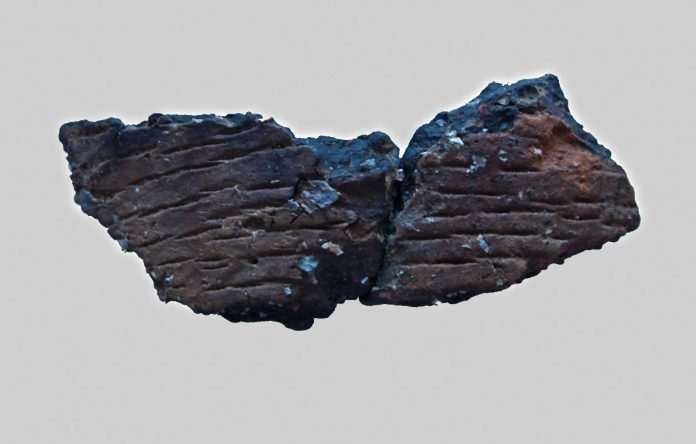The paddock site was on the northern side of Maldon Road in Langford. Langford is on the River Blackwater, at an ancient crossing-point (ford), and the site is not far from an extensive area of cropmarks representing burial sites, enclosures, field boundaries and trackways dating to the prehistoric and Roman periods.
Trust archaeologists excavated eight evaluation trenches with a total length of 140 metres on our site, and then fully excavated one corner of the site, uncovering thirteen undated features and thirteen dated features: possibly Neolithic ditch and post-hole, a Roman ditch, five medieval pits and four medieval ditches, and a modern field ditch.
The prehistoric finds
The site produced some prehistoric finds, consisting of worked flints, burnt flints and 24 fragments of pottery, which are mostly flint-tempered. Some of these fragments have been now been identified by pottery specialist Nigel Brown as being ‘Peterborough ware’ and dated to the middle Neolithic period. This is the earliest closely-dated pottery from the site. Ten fragments of this pottery, from the possibly Neolithic ditch, represent a single vessel, and Howard thinks that these fragments are especially interesting and might be displaced from a ritual deposit or burial.
Peterborough ware is dated to the middle Neolithic period and it was current during the later 4th millennium to the mid 3rd millennium (circa 3,500-2,500 BC). Peterborough ware vessels were highly decorated and would have been made by specialist potters. The ware developed from earlier Neolithic pottery and fragments of the ware usually represent one form, ie the decorated shouldered bowl. Fragments of Peterborough ware pottery are often found on low-lying monumental sites such as cursus monuments, round barrows, ring-ditches and causewayed enclosures, and even in rivers and marshy areas, including the River Thames and foreshore. Peterborough ware fragments seem to have been deliberately selected and deposited and to have had a special significance, relating to ancestors and not to the recently deceased. The vessels were decorated with impressed diagonal or herringbone patterns made using bird bones, bits of wood, or twisted and whipped cord: ‘… The vessel form of Peterborough Wares is almost exclusively the shouldered bowl … The structure of decoration on Peterborough Wares is similar to that on the earlier pottery: exclusively unbounded designs concentrated on the rim and upper body of the vessel… the decoration can be seen as a development of the same basic structure of design: the repetition of forms to fill an unbounded space, presumably starting from the top of the vessel …’ (Rethinking the Neolithic, by Julian Thomas, 1991).
The ten fragments of Peterborough ware from this site represent a single bowl with an oxidised surface which was decorated with incised or impressed horizontal lines created from small incisions or fingernail impressions. All the Peterborough ware fragments from the site show varying levels of abrasion, but the ten fragments which represent the single bowl don’t show much abrasion, which suggests that it didn’t suffer much domestic wear and tear before it was deposited. These fragments are similar to a group of fragments which have previously been recovered from the site of a Neolithic cursus monument at Springfield, near the River Chelmer, at Chelmsford in Essex (excavated 1979-85). Langford is on the River Blackwater, downstream from Springfield. The River Chelmer and the River Blackwater are closely associated *.
The site produced evidence of landscape features, ie the possibly Neolithic (or medieval) ditch, the Roman ditch, and the four medieval ditches, which suggest centuries of developing agricultural use of the land. In fact, the medieval and even the Roman pottery fragments may have been brought to the site as manure scatter. The medieval pits didn’t produce much pottery, which suggests that occupation took place during the late medieval or post-medieval period on a nearby site and not here. The fragments of Peterborough ware pottery may represent a ritual deposit or deposits and seem to suggest the site of a middle Neolithic monument in the area, which was followed by centuries of agricultural use of the land and, perhaps, a nearby settlement.
Source: Colchester Archaeology Trust

